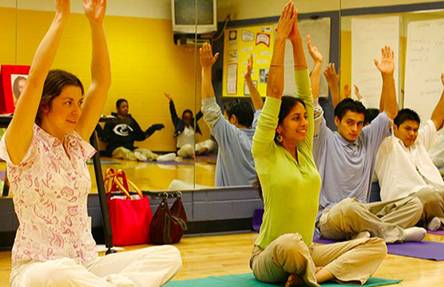Thinkpad
A Life in Social Work
 Anu talks about how she found her calling and her strength of mind, both at once through non-profit work.
Anu talks about how she found her calling and her strength of mind, both at once through non-profit work.
Anuradha Gupta, 86A6PS403
Download pdf

We used to joke that there are corporate husbands with wives that do ‘social work.’ But it was always my calling to reach out and make a difference. Sometimes because seeing people benefit was a reward in itself and sometimes because it lifted me from my mundane, existentialist dilemma. It gave my life a sense of purpose in the backdrop of the Myth of Sisyphus, rolling a boulder up a hill, moving from one day to another day where existence precedes essence.
I always noticed somebody that was in a worse situation than me. It was like the universe conspired to have me notice that. At a time when I had no job and had suffered a miscarriage (that led me to years of sadness) I noticed a lady whose child was dead, living in the slums who had to go to work the next day. It gave me strength to get my act together, get back to working and plough through so many years. I had my own little girl soon and much later adopted my son, the fourth adopted child in our family.
And yet there were 54 million children abandoned in India. And there were children who were malnourished but pushing a cycle wheel gleefully along the road. There were women who were breast feeding because there was no food in the house.
What brought joy in their hearts? Where does the peace come from in such a tough world? Growing up in India I was surrounded by such examples. There were of course the success stories, the little boy in the train who was selling bindis while singing off key and collecting money. The slums in Dharawi spawned the greatest enterprise. When child labor was banned in Varanasi carpet industry, the export factories had to furnish certification that they were child labor free. What happened to those children who would make some money working in this industry? Some would study; they had options. Rather than move in and find them options, these factories destroyed a means of livelihood. Many took to stealing and prostitution. US on the other hand that imposed this restriction and has many children working in extensive agriculture.
A kind solution for anything has to be a grassroots solution and a balanced solution. I had to connect with a corporate with a strong sense of social responsibility or non profit to make that possible.
I always thought I would be the corporate, ambitious lady and manage social work in parallel. It was wonderful being in Levers and working with villagers in Etah. It really moved me when I organized an eye camp and when I was transferred into my division. I worked with the Factory Manager of my department to improve the village around our factory, we framed our response to village development against a backdrop – that improving quality of life of villagers where we had factories and places in general would be good for the economy, kind and good for our sales most of which came from penetration into villages, small packs and mass brands like Lifebuoy. The corporate responsibility that Levers undertook with projects like Project Shakti (back in 1990’s) actually added a sense of pride and belonging to employees that cared. But moving to the US, there were different challenges. Loneliness, lack of community, I worked briefly with substance abuse and teen pregnancies and it was so disheartening, I opted to safer issues like education. I worked for a while and while the recession and prioritizing spending time with my kid made me stay at home, I started looking for non profit volunteering. The skills I brought to the table were publicity basically, project writing and grant writing I added with time.
I went through many non profits, Asha, Pratham, Anuradha Foundation, Food Allergy and Anaphylaxis Network, Lend a Hand India, BITSunami, Life for Manish which I tried to bring to BITSAA, BITS.Aid and eventually Art of Living Foundation.
There were two issues in non profits, one is that a lot of small non profits address the same issues and do not get together for critical mass because of limited budgets and the other is that in the absence of remuneration, one works because one believes in issues to turnover is very high. The needs for affirmation, achievement and power (through money, position) are all more difficult to strive for, people work from home and rarely connect and most work is pro bono. Personalities tend to govern decisions in the absence of policy sometimes. Coming from a huge corporate, this was a challenge for me always since I loved structured work.
India on the other hand is gorgeously diverse and beautifully chaotic. When India got liberalized so to say in 1991, suddenly, there was less red tape, less rules and more of international business that we were studying and since IIFT, Delhi was affiliated to the Ministry of Commerce, we were bang in the middle of a metamorphosis. A nation so large, yet democratic, secular, such dichotomies exist in every area that the mind boggles
 So how does one connect with a cause? For some it is a calling, they set up or work for non profits as employees. For others they chose from many non profits in areas like health, poverty alleviation, education, environmental issues etc. The problem is that working with causes often got one depleted. Many experience fatigue while working through a particular cause that they believe in passionately but they get hurt. Seeing children struggle to get vocational education can be tough for anybody. People get burnt out.
So how does one connect with a cause? For some it is a calling, they set up or work for non profits as employees. For others they chose from many non profits in areas like health, poverty alleviation, education, environmental issues etc. The problem is that working with causes often got one depleted. Many experience fatigue while working through a particular cause that they believe in passionately but they get hurt. Seeing children struggle to get vocational education can be tough for anybody. People get burnt out.
In that context, two non profits come to mind that are rather complete in their practice.
One is the Art of Living foundation that seeks to strengthen individuals who then contribute to social causes. The other is close to home for us BITSians, BITS.Aid which was formed three years back and then reorganized.
I must say that BITS.Aid has a very noble objective. Imagine 30,000 BITS, Alumni who are already in some way or the most connected to social causes. They have the skills, the resources, the motivation to make a difference. Improving that nexus by listing projects and getting volunteers who are anyway looking for a cause based on a particular skill (or even a job) is a formidable task.
Sudip has organized a team to relaunch BITS.Aid. I had three years back listed a project (Lend a Hand India) and been part of the initial team that included the late Laxman Mohanty, a great friend and collegue who worked for setting up schools in Orissa and many such causes.
But I have constraints and my family priorities often take over. That is where a spiritual non profit helped me; spirituality in India is often connected with going off on one’s own path, one’s own journey inwards and can be an isolating one, with people going off to Ashrams or many living in seclusion to ponder life’s mysteries. Is the purpose of self-development merely for the self? Or is it to take the knowledge to the community and serve the community with valor?
Art of Living attempts to answer these questions by instituting for its volunteers a practice that involves Sadhana, or their own strengthening practices (involving Sudarshan Kriya, yoga, breathing techniques, an ayurvedic approach to diet and health), Seva, or service and Satsang, or a community that is supportive in one’s personal growth and in helping one with service projects. And the community is organized into volunteers, coordinators (of projects and courses) as well as teachers who go through rigorous training but are mostly volunteers. Volunteers are free to undertake whatever role (they do go through a basic course which teaches them techniques) in seva and there are opportunities to connect to knowledge series which are scriptures, interpretations of Bhagvad Gita, Ashtawakra, Bhakti Sutras, Patanjali Yoga Sutras etc.
The attempt is social service in the context of personal growth and community support. Since AOL’s programs have reached 30 million people in 140 countries and there are centers all over the world, wherever one goes for a visit, to live, for a project or a course, one immediately connects with the community. We call it ‘One World Family’. Quite like the Buddhist community where there is Dharma (which is one’s own path in the journey of truth), Sangha (or the community) and Buddha (the Master) in a modern day world where nobody leaves home, like teachers often joke, the is the ‘Art of Living’ not leaving.
To think it was founded by a loving, little man we call Guruji who decided to take ‘knowledge’ and service to the masses, one is amazed as one sees how much goodwill AOL has generated in the world, with United Nations, with different countries through working in war zones, terrorist infested areas and responding with trauma care in different places.
In the US, AOL conducted free courses after 9/11 with highly trained teachers who worked with PTSD, depression and other issues using ancient Indian techniques of breathing and meditation. They went to help out at New Orleans, at Virginia Tech and local chapters being completely organic organize services the community needs.
This is fun! Art of Living is one of the world’s largest non profits and they operate so quietly and gently that most people don’t know that. They are to the non profit world what a company like say GE is to the corporate world or what a company like Unilever India is to the corporate world in India.
And to think this is all based on ancient Indian spirituality, it is a matter of great pride for Indians that we have responded to a stressful, violent world by finding an alternative. Like Sri Sri Ravi Shankar says,
“Violence Free Society
Disease Free Body
Quiver Free Breath
Confusion Free Mind
Inhibition Free Intellect
Trauma Free Memory
Sorrow Free Soul
And an Ego that Encompasses ALL
Is the Birthright of Every Citizen
On this Planet. “

So I have found yet another way of living a life in service, where I need not just write poetry about issues that overwhelm me. I can actually ‘BE THE CHANGE I WANT TO SEE IN THE WORLD.’

